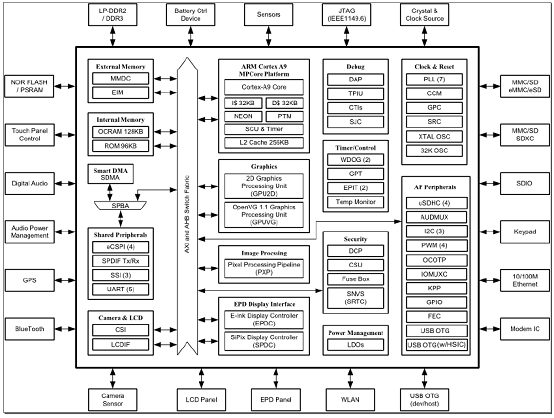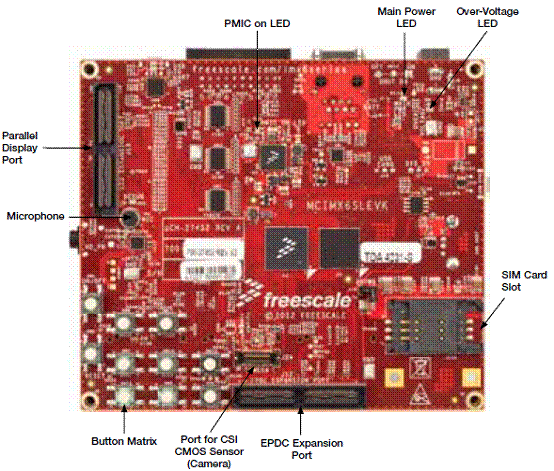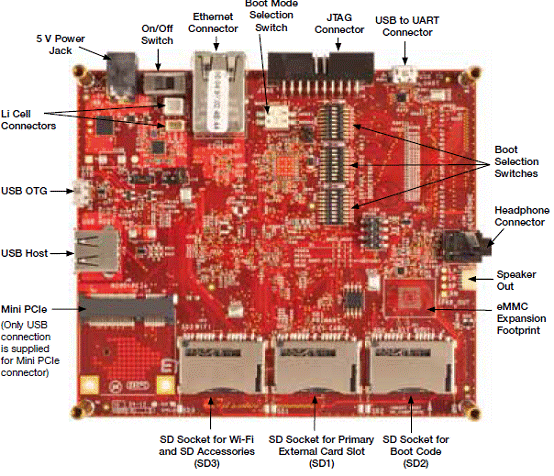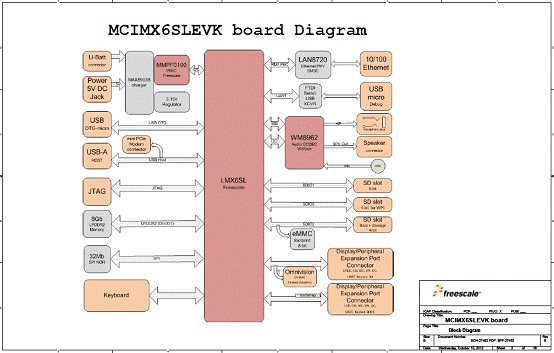Freescale i.MX 6SoloLite应用处理器开发方案
 112
112
 拍明
拍明
原标题:Freescale i.MX 6SoloLite应用处理器开发方案
freescale公司的i.MX 6SoloLite应用处理器是基于ARM® Cortex®-A9 MPCore™的多核处理器,包括2D图像处理器和电源管理,工作频率高达1GHz.处理器提供32位DDR3-800存储器接口和用于连接的多个接口如WLAN, 蓝牙,GPS,硬驱,显示和照相机传感器,主要用于彩色和单色电子书,入门级平板电脑和条形码扫描仪.本文介绍了i.MX 6SoloLite处理器主要特性,框图,以及i.MX 6SoloLite评估板IMX6SLEVK主要特性和电路图.
The i.MX 6SoloLite processor represents Freescale’s latest achievement in integrated multimedia applications processors, which are part of a growing family of multimedia-focused products that offer high performance processing and are optimized for lowest power consumption.
The processor features Freescale’s advanced implementation of the a single ARM® Cortex®-A9 MPCore™ multicore processor, which operates at speeds up to 1 GHz. It includes 2D graphics processor and integrated power management. The processor provides a 32-bit DDR3-800 memory interface and a number of other interfaces for connecting peripherals, such as WLAN, Bluetooth™, GPS, hard drive, displays, and camera sensors.
The i.MX 6SoloLite processor is specifically useful for applications, such as:
• Color and monochrome eReaders
• Entry level tablets
• Barcode scanners
i.MX 6SoloLite处理器主要特性:
• Applications processor—The processor enhances the capabilities of high-tier portable applications by fulfilling the ever increasing MIPS needs of operating systems and games. Freescale’s Dynamic Voltage and frequency Scaling (DVFS) provides significant power reduction, allowing the device to run at lower voltage and frequency with sufficient MIPS for tasks, such as audio decode.
• Multilevel memory system—The multilevel memory system of each processor is based on the L1 instruction and data caches, L2 cache, and internal and external memory. The processor supports many types of external memory devices, including DDR3, low voltage DDR3, LPDDR2, NOR Flash, PSRAM, cellular RAM, and managed NAND, including eMMC up to rev 4.4/4.41.
• Smart speed technology—The processor has power management throughout the IC that enables the rich suite of multimedia features and peripherals to consume minimum power in both active and various low power modes. Smart speed technology enables the designer to deliver a feature-rich product, requiring levels of power far lower than industry expectations.
• Dynamic voltage and frequency scaling—The processor improves the power efficiency of devices by scaling the voltage and frequency to optimize performance.
• Multimedia powerhouse—The multimedia performance of each processor is enhanced by a multilevel cache system, NEON™ MPE (Media Processor Engine) co-processor, and a programmable smart DMA (SDMA) controller.
• Powerful graphics acceleration—Each processor provides three independent, integrated graphics processing units: 2D BLit engine, a 2D graphics accelerator, and dedicated OpenVG™ 1.1 accelerator.
• Interface flexibility—The processor supports connections to a variety of interfaces: LCD
controller, CMOS sensor interface (parallel), high-speed USB on-the-go with PHY, high-speed USB host PHY, multiple expansion card ports (high-speed MMC/SDIO host and other), 10/100 =Mbps Ethernet controller, and a variety of other popular interfaces (such as UART, I2C, and I2S serial audio).
• Electronic Paper Display Controller—The processor integrates EPD controller that supports E-INK color and monochrome with up to 2048 x 1536 resolution at 106 Hz refresh, 4096 x 4096 resolution at 20 Hz refresh and 5-bit grayscale (32-levels per color channel).
• Advanced security—The processor delivers hardware-enabled security features that enable secure e-commerce, digital rights management (DRM), information encryption, secure boot, and secure software downloads. The security features are discussed in detail in the i.MX 6SoloLite security reference manual (IMX6SLSRM). Contact your local Freescale representative for more information.
• Integrated power management—The processor integrates linear regulators and generate internally all the voltage levels for different domains. This significantly simplifies system power management structure.
• GPIO with interrupt capabilities—The new GPIO pad design supports configurable dual voltage rails at 1.8V and 3.3V supplies. The pad is configurable to interface at either voltage level.
i.MX 6SoloLite主要特性:
The i.MX 6SoloLite processor is based on ARM Cortex-A9 MPCore multicore processor, which has the following features:
• ARM Cortex-A9 MPCore CPU processor (with TrustZone)
• The core configuration is symmetric, where each core includes:
— 32 KByte L1 Instruction Cache
— 32 KByte L1 Data Cache
— Private Timer and Watchdog
— Cortex-A9 NEON MPE (Media Processing Engine) co-processor
The ARM Cortex-A9 MPCore complex includes:
• General Interrupt Controller (GIC) with 128 interrupt support
• Global Timer
• Snoop Control Unit (SCU)
• 256 KB unified I/D L2 cache
• Two Master AXI (64-bit) bus interfaces output of L2 cache
• Frequency of the core (including NEON and L1 cache)
• NEON MPE coprocessor
— SIMD Media Processing Architecture
— NEON register file with 32x64-bit general-purpose registers
— NEON Integer execute pipeline (ALU, Shift, MAC)
— NEON dual, single-precision floating point execute pipeline (FADD, FMUL)
— NEON load/store and permute pipeline
The SoC-level memory system consists of the following additional components:
— Boot ROM, including HAB (96 KB)
— Internal multimedia / shared, fast access RAM (OCRAM, 128 KB)
• External memory interfaces:
— 16-bit, and 32-bit DDR3-800, and LPDDR2-800 channels
— 16/32-bit NOR Flash.
— 16/32-bit PSRAM, Cellular RAM (32 bits or less)
Each i.MX 6SoloLite processor enables the following interfaces to external devices (some of them are muxed and not available simultaneously):
• Displays—Total three interfaces are available.
— LCD, 24bit display port, up to 225 Mpixels/sec (for example, WUXGA at 60 Hz)
— EPDC, color, and monochrome E-INK, up to 1650x2332 resolution and 5-bit grayscale
• Camera sensors:
— Parallel Camera port (up to 16-bit and up to 66 MHz peak)
• Expansion cards:
— Four MMC/SD/SDIO card ports all supporting:
– 1-bit or 4-bit transfer mode specifications for SD and SDIO cards up to UHS-I SDR-104
mode (104 MB/s max)
– 1-bit, 4-bit, or 8-bit transfer mode specifications for MMC cards up to 52 MHz in both SDR and DDR modes (104 MB/s max)
• USB:
— Two High Speed (HS) USB 2.0 OTG (Up to 480 Mbps), with integrated HS USB Phy
— One USB 2.0 (480 Mbps) hosts:
– One HS hosts with integrated HS-IC USB (High Speed Inter-Chip USB) Phy
• Miscellaneous IPs and interfaces:
— SSI block—capable of supporting audio sample frequencies up to 192 kHz stereo inputs and outputs with I2S mode
— Five UARTs, up to 5.0 Mbps each:
– Providing RS232 interface
– Supporting 9-bit RS485 multidrop mode
– One of the five UARTs (UART1) supports 8-wire while others four supports 4-wire. This is due to the SoC IOMUX limitation, since all UART IPs are identical.
— Four eCSPI (Enhanced CSPI)
— Three I2C, supporting 400 kbps
— Ethernet Controller, 10/100 Mbps
— Four Pulse Width Modulators (PWM)
— System JTAG Controller (SJC)
— GPIO with interrupt capabilities
— 8x8 Key Pad Port (KPP)
— Sony Philips Digital Interface (SPDIF), Rx and Tx
— Two Watchdog timers (WDOG)
— Audio MUX (AUDMUX)
The i.MX 6SoloLite processor integrates advanced power management unit and controllers:
• Provide PMU, including LDO supplies, for on-chip resources
• Use Temperature Sensor for monitoring the die temperature
• Support DVFS techniques for low power modes
• Use Software State Retention and Power Gating for ARM and MPE
• Support various levels of system power modes
• Use flexible clock gating control scheme
The i.MX 6SoloLite processor uses dedicated HW accelerators to meet the targeted multimedia performance. The use of HW accelerators is a key factor in obtaining high performance at low power consumption numbers, while having the CPU core relatively free for performing other tasks.
The i.MX 6SoloLite processor incorporates the following hardware accelerators:
• GPU2Dv2—2D Graphics Processing Unit (BitBlt).
• GPUVG—OpenVG 1.1 Graphics Processing Unit.
• PXP—PiXel Processing Pipeline. Off loading key pixel processing operations are required to support the EPD display applications.
Security functions are enabled and accelerated by the following hardware:
• ARM TrustZone including the TZ architecture (separation of interrupts, memory mapping, etc.)
• SJC—System JTAG Controller. Protecting JTAG from debug port attacks by regulating or blocking the access to the system debug features.
• SNVS—Secure Non-Volatile Storage, including Secure Real Time Clock.
• CSU—Central Security Unit. Enhancement for the IC Identification Module (IIM). Will be
configured during boot and by eFUSEs and will determine the security level operation mode as well as the TZ policy.
• A-HAB—Advanced High Assurance Boot—HABv4 with the new embedded enhancements: SHA-256, 2048-bit RSA key, version control mechanism, warm boot, CSU, and TZ initialization.

图1. i.MX 6SoloLite处理器功能框图
i.MX 6SoloLite目标应用:
Consumer
Portable Navigation Devices
E-Readers
Media Phones
Gaming Headsets
Mobile Consumer Electronics
Remote Controls
Wireless Insulin Pump
Continuous Glucose Monitor
i.MX 6SoloLite评估板IMX6SLEVK
The i.MX 6SoloLite evaluation kit (EVK) offers a solid platform to evaluate the i.MX
6 series single-core processor built on ARM® Cortex™-A9 technology as well as a
reference for future designs.
i.MX 6SoloLite评估板IMX6SLEVK主要特性:
• i.MX6SL single ARM Cortex-A9 core operating up to 1 GHz
• 1 GB LPDDR2 (400 MHz)
• SPI NOR
• SD socket for external devices
• SD socket for boot code
• SD socket for Wi-Fi® and accessories
• eMMC expansion footprint
• Audio codec
• EPDC expansion port
• Parallel display port
• Port for CSI CMOS sensor (camera)
• SIM card slot
• Button matrix
• Ethernet
• Lithium battery charger
• USB host, USB OTG and USB to UART ports

图2. i.MX 6SoloLite评估板IMX6SLEVK外形图(顶面)

图3. i.MX 6SoloLite评估板IMX6SLEVK外形图(底面)

图4. i.MX 6SoloLite评估板IMX6SLEVK电路图(1)
责任编辑:HanFeng
【免责声明】
1、本文内容、数据、图表等来源于网络引用或其他公开资料,版权归属原作者、原发表出处。若版权所有方对本文的引用持有异议,请联系拍明芯城(marketing@iczoom.com),本方将及时处理。
2、本文的引用仅供读者交流学习使用,不涉及商业目的。
3、本文内容仅代表作者观点,拍明芯城不对内容的准确性、可靠性或完整性提供明示或暗示的保证。读者阅读本文后做出的决定或行为,是基于自主意愿和独立判断做出的,请读者明确相关结果。
4、如需转载本方拥有版权的文章,请联系拍明芯城(marketing@iczoom.com)注明“转载原因”。未经允许私自转载拍明芯城将保留追究其法律责任的权利。
拍明芯城拥有对此声明的最终解释权。




 产品分类
产品分类















 2012- 2022 拍明芯城ICZOOM.com 版权所有 客服热线:400-693-8369 (9:00-18:00)
2012- 2022 拍明芯城ICZOOM.com 版权所有 客服热线:400-693-8369 (9:00-18:00)


